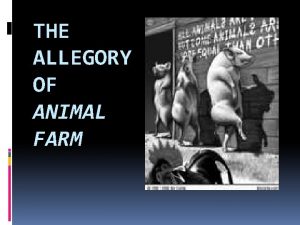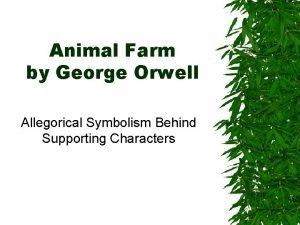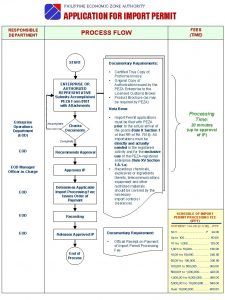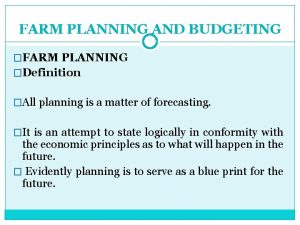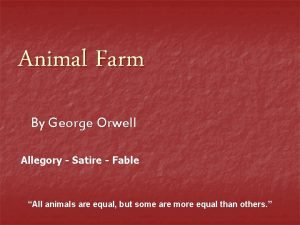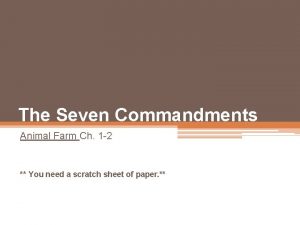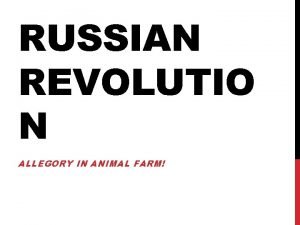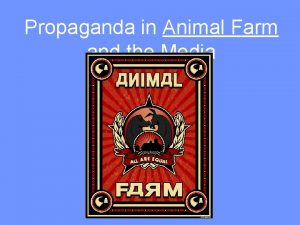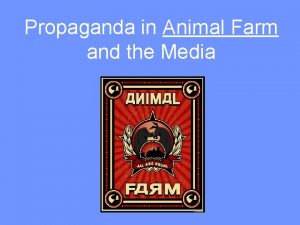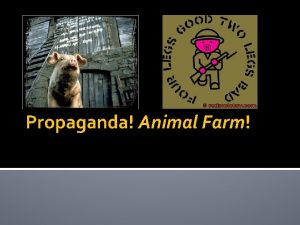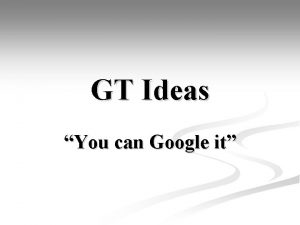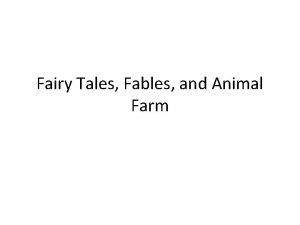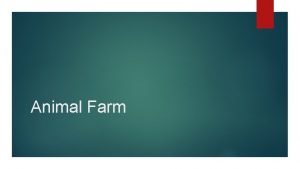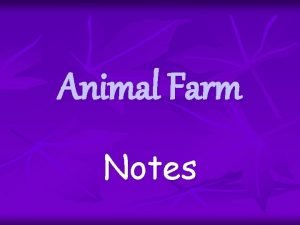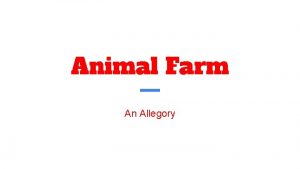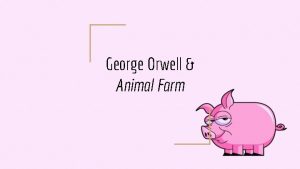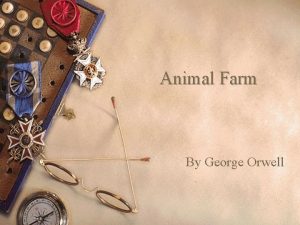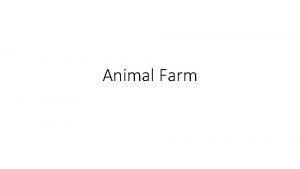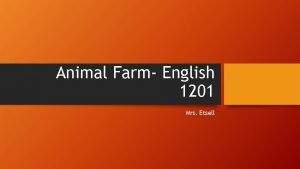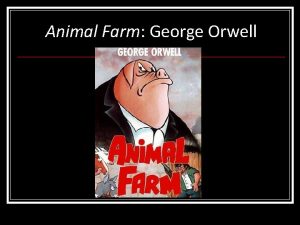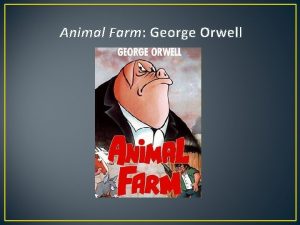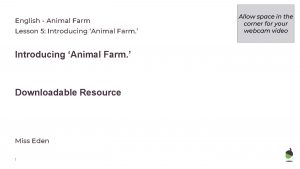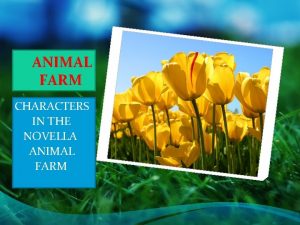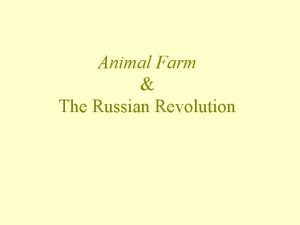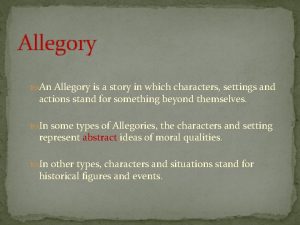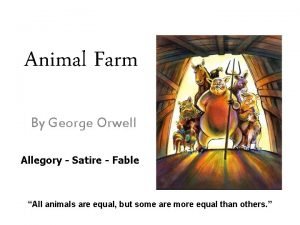Animal Farm Allegory An allegory is a story



















- Slides: 19

Animal Farm

Allegory § An allegory is a story in which characters and events are symbolic and have an underlying meaning. § An allegory has two levels: a literal and a figurative. § The symbolic meaning of an allegory is often political, religious, historical or philosophical.

Satire § The use of humour, irony, exaggeration or ridicule in order to expose and criticize an aspect of society § It challenges us to think more deeply about serious issues in life. § Through satire, a writer uses fictional characters which represent real people, in order to expose and condemn their corruption.

socialism • Socialism: the state is classless (all are equal) and the means of production are owned by the people; the benefits of work are shared by all. • Compare this to capitalism, where all the power is in the hands of a few, while the majority of people have little opportunity to improve their lives.

communism

Karl Marx • Karl Marx (considered the father of communism) stated that the only way to help people would be to create a socialist state through revolution. Communism emphasises common ownership of the means of production, and is opposed to capitalism. Communism was in force in the Union of Soviet Socialist Republics (USSR) from 1922 until 1991.

Russian revolution • Took place in 1917 – overthrew the Tsar • The people took power by force, led by Lenin, who became a hero. • After Lenin, Stalin came to power. Stalin was a cruel and selfish leader who became very powerful. • Stalin built up a force of police and spies, and had thousands of Russians killed because they did not agree with him. • He and his friends lived a life of luxury while the Russian people remained poor. The USSR began to trade goods with capitalist countries, and during WWII, became an ally with two of the most important capitalist countries – Britain and the USA.

Vladimir Lenin Leon Trotsky Driving force behind the establishment of USSR. Becomes first president. Establishes secret police. Dies in 1924. Head of early revolutionary forces. Believes in pure form of communism. An idealist. Wishes to promote communism throughout the world. Supports farmers in their grievances. Comes into increasing conflict with Stalin. Forced into exile in 1929. Assassinated in 1940. Joseph Stalin Head of the Communist Party; succeeds Lenin. Introduces five-year plans to stimulate economic growth. Brutally suppresses farmers. Undermines Trotsky and blames all problems on him. Kills millions to consolidate power. Dies in 1953.

Animal farm as an allegory • Animal Farm is thus an allegory as the main action of the novel stands for the Russian Revolution of 1917. • Animalism represents communism, and Manor Farm represents the USSR.

Napoleon’s rise to power • He trains the dogs to be his police • He makes the sheep bleat ‘Two legs bad, four legs good’ when Snowball is speaking • • • He makes the dogs chase Snowball off the farm He stopped the meetings and issued orders instead He pretended that the windmill was his idea He moved the pigs to the farmhouse He blamed Snowball for everything that went wrong He killed all those who disagreed with him and labelled them as ‘traitors’ • He only appeared seldom in public, and always with great ceremony • He took the title of ‘Leader’ and had a portrait of himself painted • He uses Squealer as a spy and also as a spreader of propaganda

Karl Marx/Lenin Animalism The Russian Revolution Mr Jones Pigs (Communists) Russian Civil War (Com. Vs non- Com) Napoleon Snowball Boxer Humans Political purges Russian Orthodox Church Sugarcandy Mountain Squealer – propagandist The secret police (KGB) Mr. Pilkington (Owner of Foxwood) Mr. Frederick (Owner of Pinchfield) World War Two The animals Farmer’s Party at Animal Farm (between Stalin

Key themes • The danger of a naïve working class • The relationship between language and power – the manipulation of language as instrumental to the control of power • Propoganda • Abuse of the word ‘equal’ • Intelligence and Education as tools of oppression • Pigs use their intelligence to deceive other animals • The pigs limit the other animal’s opportunities to gain intelligence and education




CHARACTER Snowball characters. CHARACTERISTICS Like Napoleon, he wants a leadership position. He is always arguing with Napoleon and eventually Napoleon decides to get rid of him. Snowball represents Trotsky – Stalin’s arch-rival Napoleon represents the human frailties of any revolution. He is overcome by greed and becomes power-hungry. The true side of Napoleon becomes evident after he slaughters animals for plotting against him. Napoleon becomes a dictator who was not elected by the animals. Mollie Most opposed to the new government and eventually leaves Animal Farm. She represents the typical middle-class worker who suffered under communism.

CHARACTERISTICS Boxer is dedicated and extremely hardworking, but lacks intelligence. His two mottos are: ‘I will work harder’ and ‘Napoleon is always right’. Boxer represents the Russian working class. Moses is a raven who tells the animals about a paradise called Sugarcandy Mountain. He represents the Russian Orthodox Church. Muriel is a white goat who reads the Seven Commandments to Clover whenever Clover suspects the pigs of going against one of the Commandments. Benjamin The old donkey who is not inspired by the rebellion. He believes that life will remain the same no matter who is in charge. The Dogs Napoleon trains the dogs to do exactly what he tells them to. They are aggressive and kill animals that

CHARACTERISTICS The Cat The cat is lazy and never does any work, but she does participate in the Battle of the Cowshed. Clover The female horse on the farm, she is Boxer’s faithful companion and a mother figure to the other animals. She is not intelligent enough to read. She notices that the pigs are not obeying the Commandments, but she is not smart or defiant enough to oppose them. The Sheep Loyal to the beliefs of Animal Farm and often break into chorus of ‘Four legs good, two legs bad. ’ The sheep represent people who have little understanding of their situation and thus follow their government blindly.

CHARACTERISTICS Squealer He is a brilliant speaker and can argue very well. He represents the propaganda of Stalin’s regime. Squealer plays on the animals’ ignorance and gullibility. Jones A drunkard and the owner of Manor Farm. The animals overthrow him and he unsuccessfully tries to recapture his farm. He represents the Tsar of Russia. Frederick The owner of Pinchfield. He cheats the animals out of their timber by paying for it with fake notes. He represents Adolf Hitler. Pilkington The owner of Foxwood, and represents Winston Churchill. Whymper A solicitor who acts as the animals’ intermediary to the human world. He is business-like and turns a blind eye to the injustices that occur on Animal Farm, representing the nations who
 Animal farm allegory characters
Animal farm allegory characters What was the problem with the farm tools in animal farm
What was the problem with the farm tools in animal farm What does pinchfield farm represent
What does pinchfield farm represent 8105 peza form
8105 peza form Partial budgeting and complete budgeting
Partial budgeting and complete budgeting Joseph stalin napoleon animal farm
Joseph stalin napoleon animal farm 7 commandments for our society
7 commandments for our society Animal farm excerpt
Animal farm excerpt Identifying narrative voice worksheet answers animal farm
Identifying narrative voice worksheet answers animal farm Unwarranted extrapolation in animal farm
Unwarranted extrapolation in animal farm Name calling examples
Name calling examples Repetition animal farm
Repetition animal farm Propaganda
Propaganda Animal farm narrator
Animal farm narrator Animal farm google drive
Animal farm google drive Animal symbolism in fairy tales
Animal symbolism in fairy tales Whos boxer in animal farm
Whos boxer in animal farm Animal farm ch 1 summary
Animal farm ch 1 summary Discussion questions about animal farm
Discussion questions about animal farm Animal farm conflict
Animal farm conflict
